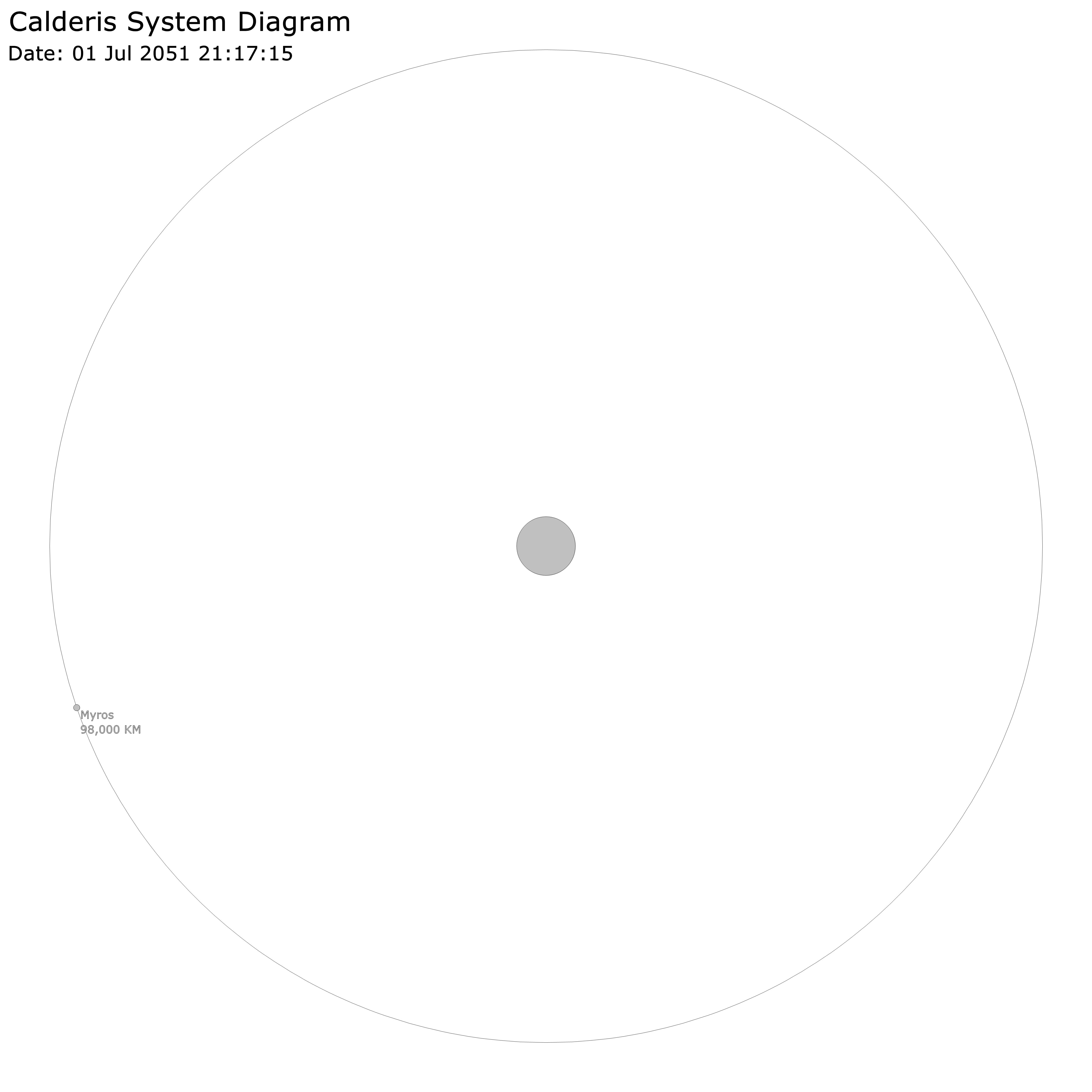Calderis
Planetary Overview
Calderis is the sixth planet in the Eidolon Star System, orbiting at a distance of approximately 1.9 AU (284 million kilometers) from the system's star. It is a cold, iron-rich terrestrial world with a radius of 6,180 kilometers and a mass approximately 0.81 times that of Earth. Calderis marks the outer boundary of the system’s inner planets and represents a transition to colder, geologically dormant planetary bodies.
Calderis is characterized by its inert tectonics, extensive regolith plains, and polar ice caps. It lacks an active hydrosphere or significant atmospheric dynamics, but its stable orbit and stratified crust offer a well-preserved geological record.
Atmospheric and Climatic Characteristics
The planet’s atmosphere is thin, with a surface pressure of only 0.26 Earth atmospheres. The composition is dominated by carbon dioxide (64%) and nitrogen (30%), with smaller amounts of argon and trace oxygen. This thin atmosphere contributes little to heat retention, resulting in an average surface temperature of 216 K.
| Gas (Formula) | Percent |
|---|---|
| Carbon Dioxide (CO₂) | 64% |
| Nitrogen (N₂) | 30% |
| Argon (Ar) | 3% |
| Oxygen (O₂) | 2% |
| Trace gases | 1% |
Weather on Calderis is minimal and mostly confined to sublimation-driven winds near the polar regions. Frost condensation can occur during prolonged night periods, especially at higher latitudes and within deep craters. The atmosphere contains a light haze of suspended dust and ice crystals, but lacks cloud systems or precipitation cycles.
Surface and Geological Features
Calderis is a largely desiccated, tectonically inactive world. Its surface is composed of oxidized silicate rock and extensive iron-rich plains. Large impact basins and craters dominate the landscape, preserved by the lack of erosion. Radar and infrared mapping indicate regions of dense, subsurface rock intermixed with permafrost and brine-rich ice at depth.
Ancient megaflood channels and collapsed volcanic calderas suggest past geological dynamism, though no current volcanism exists. Surface coloration ranges from dull ochre and red to near-black in magnetite-rich zones.
Magnetic and Seismic Properties
Calderis exhibits no global magnetic field, but crustal remanent magnetization has been detected, suggesting a once-active dynamo that has since ceased. Seismic readings indicate minimal tectonic activity, though shallow quakes and cryoseismic events have been recorded in polar regions where ice sublimation shifts surface layers.
Orbital and Gravitational Context
Calderis follows a nearly circular orbit with an eccentricity of 0.049 and an orbital inclination of 1.7 degrees. The planet's gravitational influence is localized, but it participates in shaping the outer edge of the Ereskal Belt and stabilizing small co-orbital bodies.
Surface gravity is approximately 0.92 g, allowing for moderate atmospheric retention despite low temperatures. Seasonal variation is muted due to the planet’s low axial tilt.
Moons
Calderis hosts a single significant moon:
Myros is a rocky-icy satellite with a radius of 760 kilometers. Orbiting at a distance of 98,000 kilometers, it displays surface features associated with sublimation-driven tectonics and cryovolcanism. The moon's albedo is relatively high due to surface frost deposits, and spectral analysis suggests a slush-like internal composition beneath a rigid icy crust.
Summary
Calderis is a cold, geologically ancient world with a stable but inactive interior and a surface shaped by impacts and ancient hydrological activity. Its polar ice caps, preserved crust, and relic magnetic fields make it a valuable target for studies of planetary cooling, surface evolution in low-pressure environments, and the retention of volatiles beyond the primary habitable zone.





Comments